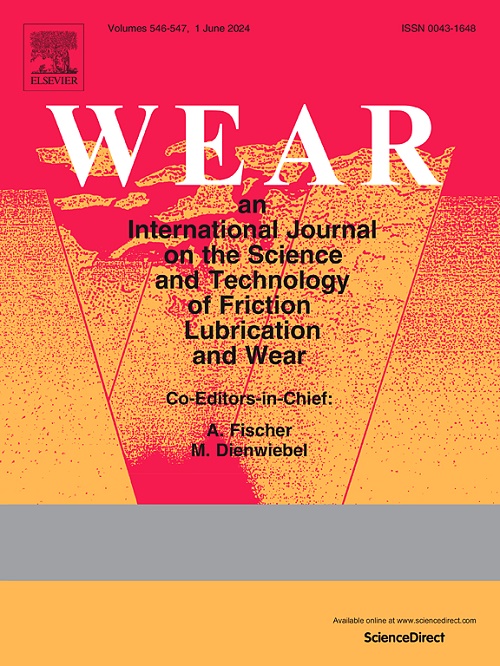基于轮轨附着力恢复效果和表面损伤的磨砂应用参数优化
IF 5.3
1区 工程技术
Q1 ENGINEERING, MECHANICAL
引用次数: 0
摘要
在低附着力条件下,用硬颗粒打磨是改善轮轨附着力的有效方法。然而,由于砂磨参数缺乏统一的标准,需要进一步研究其优化问题。采用双盘式轮轨滚动接触试验机,研究了砂敷参数对表面损伤和附着恢复的影响。结果表明,颗粒分布密度是影响粘接恢复的最关键因素,超过了颗粒大小和材料的影响。随着颗粒分布密度的增加,轮轨附着系数(附着恢复幅值)、磨损率和材料损伤先急剧增加,超过阈值后趋于稳定(约0.607 g/m)。此外,随着颗粒分布密度的增加,恢复时间(附着系数保持在适当幅度)几乎呈线性增加。粒径对附着恢复幅度的影响取决于颗粒分布密度,影响附着系数对密度变化的敏感性。虽然氧化铝具有比硅砂更好的粘附恢复效果(恢复幅度和持续时间),但造成的表面损伤明显更大。此外,为了便于现场应用,开发了一个经验方程来评估粘附恢复幅度。基于该方程,提出了针对列车运行速度在20 ~ 120 km/h范围内的磨砂量(0.6 ~ 2.2 kg/min)的分级控制策略。本文章由计算机程序翻译,如有差异,请以英文原文为准。
Optimization of sanding application parameters based on the wheel-rail adhesion restoration effect and surface damage
Sanding with hard particles is an effective method to improve wheel-rail adhesion under low-adhesion conditions. However, the lack of unified standards for sanding parameters necessitates further investigation into their optimization. This study examined the effects of sanding application parameters on adhesion restoration and surface damage using a twin-disc wheel-rail rolling contact testing machine. The results showed that particle distribution density as the most critical factor influencing adhesion restoration, outweighing the effects of particle size and material. With the increase in particle distribution density, the wheel-rail adhesion coefficient (adhesion restoration amplitude), wear rate and material damage increased sharply at first and then stabilized after surpassing a threshold (approximately 0.607 g/m). Additionally, the restoration duration (adhesion coefficient remained in a proper amplitude) increased almost linearly with an increase in particle distribution density. The influence of particle size on adhesion restoration amplitude depended on particle distribution density, affecting the sensitivity of the adhesion coefficient to density changes. While Alumina exhibited better adhesion restoration effect (restoration amplitude and duration) than Silica sand, it resulted in significantly greater surface damage. Furthermore, to facilitate field applications, an empirical equation was developed to evaluate adhesion restoration amplitude. Based on this equation, a graded control strategy for sanding amounts (0.6–2.2 kg/min) was proposed, related to train operating speeds ranging from 20 to 120 km/h.
求助全文
通过发布文献求助,成功后即可免费获取论文全文。
去求助
来源期刊

Wear
工程技术-材料科学:综合
CiteScore
8.80
自引率
8.00%
发文量
280
审稿时长
47 days
期刊介绍:
Wear journal is dedicated to the advancement of basic and applied knowledge concerning the nature of wear of materials. Broadly, topics of interest range from development of fundamental understanding of the mechanisms of wear to innovative solutions to practical engineering problems. Authors of experimental studies are expected to comment on the repeatability of the data, and whenever possible, conduct multiple measurements under similar testing conditions. Further, Wear embraces the highest standards of professional ethics, and the detection of matching content, either in written or graphical form, from other publications by the current authors or by others, may result in rejection.
 求助内容:
求助内容: 应助结果提醒方式:
应助结果提醒方式:


